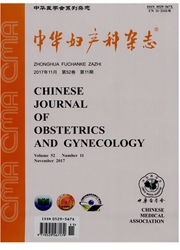

 中文摘要:
中文摘要:
目的探讨胎盘endoglin(Eng)表达的变化与重度子痫前期(severepreeclampsia,SPE)发病的关系。方法纳入2006年1月至2008年1月在北京大学第一医院分娩的SPE患者49例(SPE组),其中合并胎儿生长受限(fetalgrowthrestriction,FGR)9例,合并溶血、肝酶升高和血小板减少(hemolysis,elevated liverenzymes,andlow platelets,HEI,LP)综合征6例,合并大量蛋白尿12例;正常妊娠40例(对照组)。以免疫组织化学方法定位和半定量检测2组孕妇胎盘中Eng的表达强度。统计学分析采用独立样本t检验。结果免疫组织化学染色显示Eng表达于胎盘合体滋养细胞和血管内皮细胞膜。SPE组胎盘Eng表达强度较对照组升高(0.1621±0.0029与0.1576±0.0038,t=-6.367,P〈0.05)。SPE组中,合并FGR组和无FGR组(0.1611±0.0026与0.1623±0.0029,t=1.107,P〉0.05)、合并大量蛋白尿组和无大量蛋白尿组(0.1611±0.0032与0.1624±0.0027,t=1.350,P〉0.05)胎盘Eng表达强度差异无统计学意义;合并HELLP综合征组较无HEI。I。P综合征组胎盘Eng表达强度降低(0.1595±0.0032与0.1625±0.0027,t=2.495,P=0.016)。结论胎盘Eng表达强度升高可能与SPE的发病有一定关系。
 英文摘要:
英文摘要:
Objective To investigate the relationship between placental endoglin expression and the pathogenesis of severe preeclampsia (SPE). Methods Forty-nine pregnant women with SPE and 40 normal pregnant controls were collected in Peking University First Hospital from January 2006 to January 2008, among which, nine SPE patients complicated with fetal growth restriction (FGR), six with hemolysis, elevated liver enzymes and low platelets syndrome (HELLP syndrome) and 12 with heavy proteinuria. The expression of placental endoglin was detected and semi-quanti{ied by immunohistochemistry. Data were analyzed by independent sample t test. Results Endoglin was presented on cell membranes of placental syneytiotrophoblasts and vascular endothelial cells. The endoglin density of SPE group was higher than that of control group (0. 1621±0. 0029 vs 0. 1576± 0. 0038, t=--6. 367, P〈0.05). No significant difference in endoglin density was found between FGR group and non-FGR group (0. 1611±0. 0026 vs 0. 1623 ± 0. 0029, t= 1. 107, P〉0.05) ; neither did the heavy proteinuria group and non-heavy proteinuria group (0, 1611±0, ooa2 vs o. I6244-0. 0027, t=1. 350, P〈0. 05). The endoglin density of HELLP group was lower than that of non-HELLP group (0.15954-0.0032 vs 0.16254-0.0027, t=2.495, P=0.016). Conclusions The elevated placental endoglin expression might contribute to the pathogenesis of SPE.
 同期刊论文项目
同期刊论文项目
 同项目期刊论文
同项目期刊论文
 Dynamic change of Adamalysin 19 (ADAM19) in human placentas and its effects on cell invasion and adh
Dynamic change of Adamalysin 19 (ADAM19) in human placentas and its effects on cell invasion and adh Effects of Type I Gonadotropin-releasing Hormone (GnRH) and Type II GnRH on Cell Invasion in Human C
Effects of Type I Gonadotropin-releasing Hormone (GnRH) and Type II GnRH on Cell Invasion in Human C Dual effect of transforming growth factor beta 1 on cell adhesion and invasion in human placenta tro
Dual effect of transforming growth factor beta 1 on cell adhesion and invasion in human placenta tro Expression of SWAP-70 in the uterus and feto-maternal interface during embryonic implantation and pr
Expression of SWAP-70 in the uterus and feto-maternal interface during embryonic implantation and pr Effect of matrix metalloproteinase-26 on cell invasiveness in human choriocarcinomal cell line JEG-3
Effect of matrix metalloproteinase-26 on cell invasiveness in human choriocarcinomal cell line JEG-3 An immortalized normal human cytotrophoblast cell line generated by exogenous expression of telomeri
An immortalized normal human cytotrophoblast cell line generated by exogenous expression of telomeri 期刊信息
期刊信息
